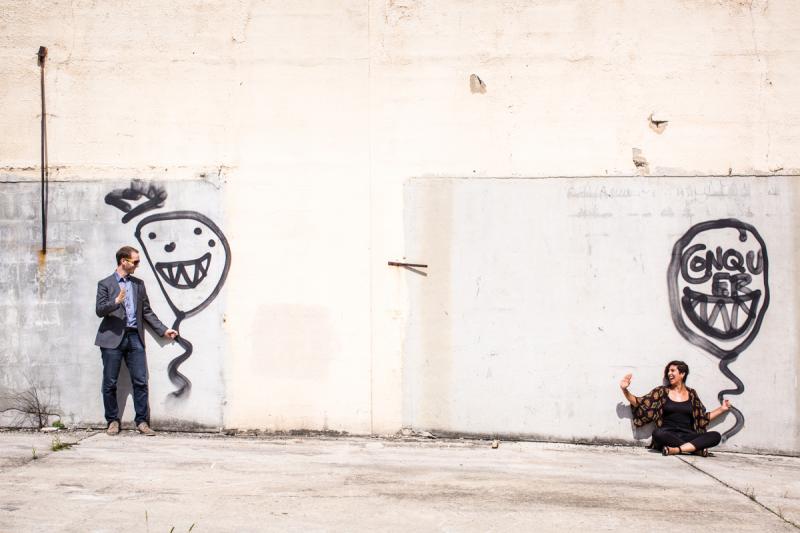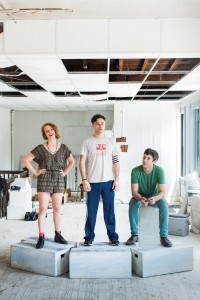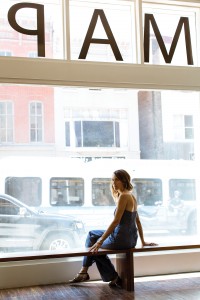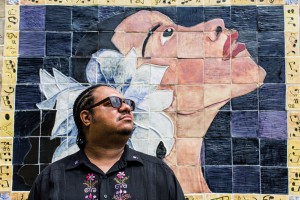
Eight million dollars. That’s how much money three local artists need to make their dream a reality. In spring 2014, Carly Bales, performer and co-founder of the local EMP artist collective, Evan Moritz, co-founder of the Baltimore Annex Theater, and Ric Royer, a veteran performing artist and curator/organizer who recently returned to Baltimore after stints in New York and Providence, responded to a request for proposal (RFP) for three vacant, city-owned properties located in the recently designated Bromo Tower Arts and Entertainment District downtown. The RFP was issued by the nonprofit Baltimore Development Corporation (BDC), which has a contract with the city to foster economic development. One service it provides is fielding business ideas for publicly owned buildings. In the RFP, Bales, Moritz and Royer saw an opportunity—and a way to continue being artists in Baltimore.
They dreamed up Le Mondo, an artist-owned-and-driven creative home, a per- formance and culture hub for emerging local artists and arts organizations and a community anchor in a developing neighborhood. They first reached out to other small arts organizations—the incarcerated young people program Baltimore Youth Arts, local theater groups Acme Corporation, Stillpointe Theatre Initiative and Annex Theater, and experimental dance company Effervescent Collective—for their creative input and ideas. They partnered with local developer Winstead “Ted” Rouse, who put them in touch with architects who could help them evaluate what needed to be done to the buildings to transform them into an arts space.

The first estimate of $8 million was daunting. That’s a few million over the budgets of their current endeavors, where all-volunteer staffs organize and curate exhibitions, stage productions and conduct workshops for $30,000 or less a year. “We were getting into the world of real estate development as artists,” Bales says of their initial meetings to turn their RFP idea into an operational plan. They needed to figure out what tax credits they were eligible for. They needed to figure out if the building could qualify for historical tax credits. They needed to figure out what needed to be demolished and what needed to be rehabbed. And they were doing it in the time between operating their do-it-yourself arts organizations and working jobs that supported their lives.
“When we started meeting with architects and contractors and working out all the fees that are incumbent with even trying to fundraise to get the tax credits, it was a little overwhelming,” Bales says.
Moritz and Royer point out that over time, the oppressive original figure decreased to $7.5 million and currently stands around 6. Still, the difference between $30,000 and any million is pretty steep, but that monetary shift of scale is the challenge facing local artists and arts organizations today: How to be an artist in a city where its arts and culture capital have become key components to its economic revitalization plans, and at the same time how to negotiate accelerating living and operating costs.
Le Mondo is at the beginning of the idea-to-actuality process that all arts organizations must navigate. Whether a small community center or major cultural institution, arts organizations have often started because a person or group of people wanted a place to call home for the art they loved. They often spend the rest of their time and lives trying to keep the doors of that home open.
To hear the local arts org leaders talk about it, they all spend most of their energy working to keep the organizations stable, which comes through a mix of funding models that involve philanthropic and government grants, private donations and something perhaps less easy to quantify or define.
In 1981 a group of artists and their allies started Maryland Art Place, an exhibition space for working artists; in December 2013 MAP moved from the Inner Harbor to the 218 W. Saratoga Street building the organization purchased in 1988, relocating to the newly designated Bromo Tower Arts and Entertainment District.

Amy Cavanaugh Royce became the executive director of MAP in 2012, and she says she’s spent most of her time trying to get the organization on more solid financial footing, an effort that included moving back to the building it owns. “There’s been serious ups and down, and very significant change in board leadership had a big part of that,” she says. “We had to clean up our audit and get rid of that debt on the [Saratoga Street] building that we own, so the decision to move was financial and programmatic. Financial in that sustaining two facilities is not sustainable. And when the Bromo designation took effect [in fall 2012], it was kind of like, ‘what are we doing?’
“I’ve pretty much spent three years lobbying my board to move the organization and then moving it, and that was not easy,” she continues. “I think that today organizations of MAP’s size, which should be operating around a half million dollars a year—ideally, we’re not there now—need a third source of revenue.” (In MAP’s case, rent from tenants in its building.) “Because arts funding is extremely competitive and individual philanthropic money is harder to come by. The donor is much more picky about where they give their dollar, and they’re also more involved in what happens to those dollars.”
In the late 1960s, a grassroots effort to provide an after-school performing and visual arts center laid the groundwork for the Eubie Blake Cultural Center, officially named in 1983—and, since 2000, based at 847 N. Howard Street—a building the Center purchased from the city for a dollar.
When Troy Burton, executive director of Eubie Blake, started noticing donors wanting to take a more active role in programming and operations, he recruited them into a committee he calls the Friends of the Eubie Blake Center. And when he started noticing funding dry up in the years following the 2008 recession, he realized he needed to push his board to become more active in the fundraising process.

“We’re still struggling,” Burton says. ‘Everybody is. I find that the Eubie Blake Center is applying for some of the same grants now as some of the major organizations, like the BMA and the BSO. There was a time when we were never in the same category for funding at the city and state levels. So you’re competing with some of the major ones, and we don’t necessarily have the resources they do. So right now I feel as though I’m turning the corner with the center and my board of directors to get them to understand that it has to be a fundraising board or we will not be able to keep our doors open. Grants—that’s not going to be the only thing that gets us there.”
Who and what financially supports local arts organizations isn’t easy to pin down. More than 300 such organizations call Baltimore home, and they’ve all felt the economic strain of the past decade, when cuts to the arts budget under Gov. Martin O’Malley preceded the recession of 2008, which caused a dip in supporting funds across the board—governmental support, philanthropic giving, and donations from private corporation and individuals. Arts organizations have always run lean, so post-recession they weren’t simply trying to find ways to maintain their missions, but also competing with each other for the same smaller pool of funds, often from the same donors.
The crunch caused some donors to become more interested in how their money was being spent. “I think people pay more attention to where their dollars in general are spent these days,” Royce says. “People are giving philanthropically more as an investment and less as a charitable donation. They’re looking at what the return is, and for some it’s just having their name on the wall. For others it’s having a say in what’s happening programmatically. The biggest systemic issue: People just won’t give operating dollars, and operating dollars are small.
They expect wonderful and miraculous programs, but they don’t want to pay anyone to run them. So I think there’s a huge disconnect in what it costs to operate something—it’s just not glamorous to the donor to give to somebody’s health care benefits.”
At the same time, arts and culture became buzzwords for urban renewal across the Reagan-de-regularized country—an idea floated in Baltimore during the 1987-1999 era of the Kurt Schmoke mayoral administration, but which took root under Martin O’Malley in the early 2000s. In 2002, the state created its first arts and entertainment districts, which come with tax credits and incentives for artist live-work spaces and arts- and entertainment-related businesses. And the neighborhood organizations that work in them—the Station North Arts and Entertainment District, Inc. and the Bromo Tower Arts and Entertainment, Inc.—are part arts advocates, part development catalysts, which make strange bedfellows.
Artists know better than anyone else that urban gentrification doesn’t start when the developers arrive but, rather, when they do, and trying to be part of the communities in which they live and work—and not temporary transplants—is a constant battle. “Real estate is a big part of what we end up talking about when we talk about arts districts,” says Priya Bhayana, director of the Bromo Tower Arts & Entertainment, Inc., which was created in 2012 in large part by the Baltimore Office of Promotion and the Arts in partnership with the Downtown Partnership of Baltimore and the Market Center Merchants Association. As an organization, it’s still figuring out what its role needs to be in the district, but providing opportunities for artists to live and work in the area is a huge part of that discussion.
One chip the org knows it can’t rely on solely as a growth strategy in 2015: Hey, we’re making art for art’s sake—help us out. It is essential to lead with their social and economic value.
“It may just be that I track these more but I do feel that there is more of the social-driven or creative place-making arts funding available [right now]. I feel like there are also so many organizations positioning that way—not just in Baltimore, but nationally. Maybe [that model] is easier to work with. It’s something that touches on a lot of different issues. It has a social value, it has economic value, in theory, and in some ways it may be an easier sell than art for art’s sake.”
These city-focused development and promotional organizations enter the arts funding discussion because their enlightened self-interest has made them advocates for the arts and artists, as well as organizations that compete for, and sometimes redistribute, the same funds from the same pool of sources.
“A lot of our work is intended to build momentum and attract partners to the point where someone might start a capital campaign for a new arts space,” says Ben Stone, executive director of the Station North Arts and Entertainment District, Inc., (SNAED) in talking about the large-scale, arts-related projects in his district such as the renovation of the Parkway and Centre theaters, collaborations that involve, among others, the Johns Hopkins University, MICA and the Maryland Film Festival.
“And perhaps where I’ve made a mistake: We haven’t quite figured out what happens next after that. We found a lot of our funders are scaling back some of the funding they’re giving us, though still supporting Station North as a district, because they might be funding a capital campaign here. The Parkway is a $17 million renovation project, so they’re talking to all the foundations who are supporting us and more, as they should be. The Motor House is also raising money. All these projects need millions and millions of dollars. And foundations are acknowledging that they’re giving out quite a bit of money to this part of the city. And if they draw a map to show where their funding priorities are, it’ll still show that it’s going to Station North.”
That money might not be going directly to SNAED, Inc., which has used previous monies to stage projects such as the Open Walls Baltimore exhibition of mural art in the district. “We, like every other organization you talk to, have the challenge between program-specific funding and general operating funding,” Stone says, adding that SNAED is fortunate in that it has a decent number of funders that understand the need for general operating expenses. “Paying your insurance, paying an accountant to do your books, paying staff and that non-sexy stuff is really, really important to stay in business and maintain your nonprofit status. It’s actually rather expensive, when you put it all together, especially when you start managing spaces and your hot water heater dies and you become a property manager without intending to be one. I just had to buy a new ladder. A ladder is $300—a small part of our overall budget, but one thing that I never really thought about. There’s a million small things like that.”
Those million small things sound like the familiar complaints of homeowners: It’s yours, but there’s always something that needs fixing, and you never know when something is just going to stop working entirely. “We’ve started trying to spread out the risks as much as possible because at most foundations, people eventually do get tired,” Stone says. “People want to fund different things for a few years and move on.”
That’s a familiar refrain said by many longtime arts organizations: that being able to survive for a while lends the impression that the organization doesn’t need sustained support. And that’s if an organization is lucky enough to have access to grants in the first place.
Barriers also exist for artists and arts organizations that don’t have the familiarity or access to the same funding pipelines because of class, race or ethnicity. Baltimore is a predominantly African- American city whose arts institutions—and, in many cases, the potential funding sources—are overwhelmingly white-run.
Prior to the unrest that followed the death of Freddie Gray, which threw the city’s decades-long racial and economic inequality into the national spotlight, artists and arts organizers, black and white, were talking about these barriers. In January, artist/activist Sheila Gaskins co-organized the forum, “Art-Part’heid: Bridging the Gap of Disparities in the Baltimore Arts Scene,” to discuss the lack of people of color receiving access to arts funding, and unequal representation on governing boards and jury committees.
Baltimore is also a small city with a small, interconnected arts community. I am employed by the Johns Hopkins University, one of the anchor institutions and funding sources for Station North, and I have contributed to BmoreArt, the online arts journal supported in part by the Robert W. Deutsch Foundation in Towson, which is also involved in Station North through grants and its financial support of the Baltimore Arts Realty Corporation, a nonprofit development organization that bought the former Load of Fun artists’ studios in 2013 and is turning it into the Motor House mixed-use artists’ space. Jessica Bizik, the editor-in-chief of this magazine, sits on the board of trustees for Maryland Art Place.
The intersection of all these players—funding organizations and local institutions, artists and real estate developers, arts advocates and private donors—creates a thorny situation. The language of creative place-making projects—and the goals of some of the private organizations that fund them—often has the effect of explicitly implicating the arts and artists in urban renewal that aligns their labor with gentrifying efforts. Not every artist wants to be so implicated.
“Maybe I haven’t worked in nonprofit or arts institutions long enough to say this, but I don’t think the idea that arts and culture fuels community revitalization or development is anything new,” Bromo district’s Bhyana says. “I think this is how funding works. It reinvents terms and reframes the conversation. Creative place-making is what it is.”
The problem is that artists are learning to talk economic development and social impact, but virtually nobody—on either side—is talking about the art itself.
“I’m trying to put this in a way that won’t get me into trouble,” Stone says. “I don’t know if it’s a national trend, but I find very frequently when it comes to these conversations about economic development and the arts or community development and the arts, that the ‘arts’ is such a big world that nobody takes a step back and says, What we really mean is quality art created by talented artists. I usually assume that’s what people mean, but that also assumes that the people who are doing the talking are artists or have a background in it and can converse in it. I know that sounds snobby, but art is like any other field—you have to know what you’re talking about. And there’s many ways of getting to a place of authority, but authority is important in the art world just as in other worlds. So you find a lot of very superficial projects going on where it’s just, any art is fine, paint something on a wall, make a sculpture, who cares if that artist knows what he’s doing or has any experience making art for this place and setting.
“That’s something that often gets left out of conversation—where is the talent and how do we push each other?” he continues. “Baltimore’s getting a lot better at this, but still has room to grow.”
Bales, Moritz and Royer’s history as local artists is marked by the nomadism created by development under the guise of renewal. These three understand exactly what kind of complicated situation they’re entering into with Le Mondo.
For this interview, they met up at a bar in Station North, a place all three used to call home for their arts organizations. EMP debuted in the January 2010 with a performance in the 1810 Falls Road building currently being renovated by MICA. Annex debuted in 2008 at the Copy Cat Annex building on Oliver. From 2008 through January 2010, Royer ran the LOF/t, a performance space at the North Ave. Load of Fun Studios (opened by artist Sherwin Mark in 2005).
Until July of this year, Annex resided in the district, based on a partnership with SNAED, which began renovating the space at 1 W. North Avenue, also known as the Chicken Box. EMP currently resides temporarily in a storefront on West Baltimore Street downtown, a relocation from a previous temporary space at 306 W. Redwood that the collective secured through a $10,000 Downtown Partnership’s Operation Storefront grant in 2011.
As you might imagine, the Le Mondo trio would like to find a way to stay in one thriving place in coming years. What keeps Baltimore’s arts community unique and flourishing is a steady stream of experimentation, risk-taking and all-around creative activity by its artists across age demographics. That activity is frequently incubated by a loose network of small to mid-sized arts spaces and organizations that provide everything from studio and exhibition space to grants and residencies. In recent years, a number of DIY performance spaces have been closed or otherwise displaced, and a growing absence of alternatives threatens to stifle what makes Baltimore’s art community so distinctive.
“We’re seeing a decrease in DIY spaces and, at the same time, no real increase of anything that’s actually sustainable for a small arts organization,” Moritz says. “So you don’t have the ability to grow and to do weird, fucked-up shit at zero dollars. So you’re stuck in the $30,000 by-hook-or-by-crook experimental model for years to come if we don’t find a way to solve some of those problems.”
In June, the BDC asked Le Mondo to raise $50,000, which it sought through the site Crowdrise.com. Le Mondo thinks of this amount as the ante to show that they have some skin in the arts-and-culture development game. We’ve raised this amount—can you match it?
Such is the basic outline of a multi-stage capital campaign. “Several million dollars is an overwhelming amount, but when we break it down into stages, it seems more doable,” Bales says. At the time of the interview, the Crowdrise campaign was ongoing, and periodically their phones would vibrate with contribution notifications. The $50,000 is part one; by year’s end they want to raise $75,000.
That’s still a ways off from $6 million, but Royer says when he first heard the $8 million figure he thought, Yeah, right, we know how to do things cheaper. Developers “don’t understand that [artists] know how to get things done for less,” he says, adding that a very important experience he had after he left Baltimore in 2010 was working at AS220, the artists-owned nonprofit organization and live/work studio space started 30 years ago in 1985 in downtown Providence. It began as a single loft space. Now AS220 owns and runs three buildings, providing space and resources that are open to all.
AS220 is “a great inspiration,” Royer says. “It’s an artist-owned neighborhood. They have changed downtown. And they’re doing it in a way that we’re modeling a lot of what we’re talking about socioeconomically and how to make it survive… So anytime that I think a dollar figure is too big, a project is impossible, I think back to AS220 and know that it is possible and there is precedent. There may not be precedent in this city, but there can be. Having worked there for three years…it’s always been a place that I can go mentally and say, We can do this. I wouldn’t have relocated my life again if I didn’t think it was going to happen.”
The Le Mondo crew knows it’s going to be an uphill battle that’s not going to level off. Burton has worked with and for the Eubie Blake Center since college, and he would love to see the city’s leaders back up the talk behind its arts plans. “Baltimore, in my opinion, has always been a testing ground, and I’ve had enough of that,” he says. “When are we going to stop testing and do it? Because it has been done. This city has proven that it can produce some of the greatest artists in the world. But working with a lot of individual artists I find that they have to leave Baltimore [to succeed]. Why can’t our artists work and live in Baltimore? Sure, they can go elsewhere and abroad. But when they come home, they should be able to work as artists.”




